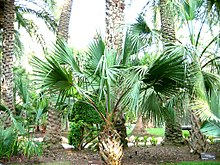Sabal bermudana
| Sabal bermudana | |
|---|---|

| |
| Individual in a Spanish botanical garden | |
| Scientific classification | |
| Kingdom: | Plantae |
| Clade: | Tracheophytes |
| Clade: | Angiosperms |
| Clade: | Monocots |
| Clade: | Commelinids |
| Order: | Arecales |
| Family: | Arecaceae |
| Genus: | Sabal |
| Species: | S. bermudana
|
| Binomial name | |
| Sabal bermudana | |
| Synonyms[2] | |
| |
Sabal bermudana, commonly known as the Bermuda palmetto or bibby-tree, is one of 15 species of palm trees in the genus Sabal and is endemic to Bermuda although reportedly naturalized in the Leeward Islands.[3] It was greatly affected by the introduction of non-native plants such as the Chinese fan palm, which created competition for space that it usually lost.[4]
Description
Sabal bermudana grows up to 25 m (82 ft) in height, with the occasional old tree growing up to 30 m (100 ft) in height, with a trunk up to 55 cm (22 in) in diameter. It is a fan palm (Arecaceae tribe
Uses
Bermudians used to use, for a short period, the leaflets of the palm to weave into hats and export them to the United Kingdom and other countries. Sabal bermudana also had holes drilled into its trunk and sap extracted to make "bibby", a strong alcoholic beverage.
During the 17th century, most houses in Bermuda had palmetto-thatched roofs.
References
- . Retrieved 19 November 2021.
- ^ The Plant List Sabal bermudana
- ^ Kew World Checklist of Selected Plant Families, Sabal bermudana
- ^ Bermuda Department of Conservation Services, Bermuda Palmetto Page. Archived 2010-03-05 at the Wayback Machine
- ^ Bailey, Liberty Hyde. 1934. Gentes Herbarum; Occasional Papers on the Kinds of Plants 3: 326, Sabal bermudana

